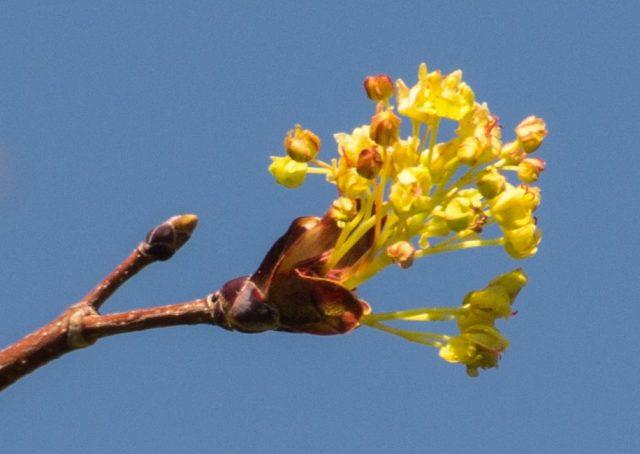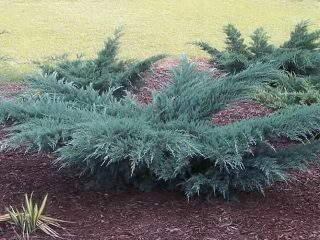Content
Maple Crimson Sentry is one of the most popular red-leaved varieties of the crop. Valued for its compact crown, unpretentiousness and high decorative qualities. However, in order for the grown tree to fully comply with the declared characteristics of the variety, it is necessary to provide it with care taking into account its basic requirements.

Crimson Sentry is a slow growing species
Breeding history
This decorative variety of Norway maple was officially registered in 1970. Work on its breeding was carried out in the nursery of A. McGill and Son, Oregon in the USA. Subsequently, the Crimson Sentry maple spread to Western Europe and the European part of Russia.
Description and characteristics of Crimson Sentry maple
To be able to distinguish this species from other varieties of Norway maple, you need to know its characteristics. Therefore, it is worth familiarizing yourself with the description and characteristics of Crimson Sentry.
Height of Crimson Sentry maple
This deciduous tree is characterized by moderate growth. Its height reaches 7-8 m, and the diameter of the crown growth is about 4 m.Maple branches are short, directed upward, growing from the very bottom of the trunk. Young shoots are light brown. The buds are red-brown. The crown of the Crimson Sentry maple is pyramidal, narrow, and dense.
The bark on the main trunk and mature branches is dark gray. Long longitudinal cracks are clearly visible on it.
The Crimson Sentry maple can also be grown on a trunk or as a bush. The first option should be considered if it is necessary to obtain a small tree, since the growth of the main trunk in this case is limited.
Leaves
The Crimson Sentry maple has 5-7 lobed, arched, jagged leaves. The ends of the blades of the plates are pointed. The plates are dark red in color, with a shiny surface. It has been noticed that at the beginning of the season, the maple variety Crimson Sentry has crimson leaves, in the summer it fades slightly and turns purple, and with the arrival of autumn it acquires its original color.

The length of the leaves of the variety does not exceed 15 cm
Fruit
The fruits of the Crimson Sentry maple are similar to those of other types of crops, namely two-lobed impellers, with wings 3.5-5.5 cm long located almost horizontally. They have the ability to split into two single seeds, which the wind carries over long distances .
The seeds of the Crimson Sentry maple are bare and have a flattened shape. They have a thin skin and a large, coiled embryo. The variety bears fruit annually.
Root
The root system of the Crimson Sentry maple is of a superficial type. In an adult tree, the main part of the shoots is concentrated in the humus layer. The skeletal roots of the maple do not extend beyond the diameter of the crown growth.
Flowering period
The flowers of the Crimson Sentry variety are small, yellow-green in color. They are collected in spectacular corymbose inflorescences, which increases the decorative value of the variety. When the buds bloom, they emit a pleasant aroma that fills the entire space around the tree.
The flowering period of the Crimson Sentry maple begins in the first half of May and lasts up to ten days. The buds open on the tree before and during leaf bloom.

Tree flowers are pollinated by insects
Application
Crimson Sentry can be used as a tapeworm, and also as a contrasting element in group plantings. The tree tolerates polluted air well, so it is recommended for landscaping parks, squares, and gardens. This variety is also suitable for growing near residential buildings.
Features of cultivation
Planting a tree can be done in early spring or late autumn. The distance between several seedlings should be 3 m so that they do not interfere with each other’s development. A sunny place, protected from cold gusts of wind, is suitable for Crimson Sentry.

With a lack of light, the color of the leaves becomes faded
For the seedling, you need to prepare a hole measuring 60 by 60 cm. A 10 cm layer of drainage must be poured onto the bottom of it, and the rest of the space must be filled with a soil mixture consisting of humus, turf and sand in a ratio of 1:2:1. You also need to additionally add 60 g of superphosphate and 40 g of potassium sulfide, and then mix the fertilizers with the soil.
Planting is carried out in the standard manner. Upon completion, the root collar of the seedling should be 2 cm above the soil level.
Maple Crimson Sentry does not require complex care.The tree needs to be watered regularly, preventing the roots from drying out. During hot periods, it is recommended to lay mulch at the base of the maple to reduce evaporation.
Periodically during the season it is necessary to loosen the soil in the root circle to maintain air access to the roots, as well as to remove growing weeds. It is recommended to feed the Crimson Sentry maple twice a season. In the spring, you need to lay humus in a layer of 3-5 cm in the root circle, and in mid-July add 100-150 g of superphosphate and 50-100 g of potassium sulphide, followed by embedding it in moist soil.
Pruning is required for the Crimson Sentry maple to give the crown a neat appearance if necessary. It should be carried out in early spring, removing broken and damaged shoots. It is also recommended to get rid of root shoots and branches growing in the middle that stand out from the general mass.
It is necessary to cover the Crimson Sentry maple for the winter for 2-3 years after planting, until the seedling acquires the maximum level of frost resistance. To do this, it is recommended to wrap the maple trunk in burlap in late autumn and secure it with rope. It is also necessary to cover the root collar with spruce branches.
Reproduction
The Crimson Sentry maple can be propagated by root shoots, seeds and air layering. In the first case, it is necessary to dig up seedlings located away from the trunk along with root shoots in early spring. After this, plant it in a permanent place and water it abundantly.
When propagating by seed, it is recommended to sow in the soil in October. The optimal planting depth is 5-7 cm. After this, sprinkle the seeds with soil and cover with a 3-5 cm layer of humus. With the arrival of spring, sprouts will appear.When the seedlings become stronger, they can be transplanted to a permanent location.
To propagate the Crimson Sentry maple using aerial cuttings, you must select a semi-lignified young shoot. At a distance of 20-30 cm from the top, it is necessary to make oblique cuts in the bark and pour root former powder into them. After this, insert small grains of polystyrene foam into the wounds so that their edges do not grow together, then cover them with damp moss and wrap them in polyethylene, and on top with foil to protect them from overheating. Periodically, the substrate needs to be moistened. When roots appear on the shoot, it must be separated from the main branch and planted in the ground along with moss.

Seedlings grown from air layering take root most quickly.
Diseases and pests
The Crimson Sentry maple is susceptible to powdery mildew. In this case, its leaves become covered with a white coating, which becomes brown over time. This leads to disruption of photosynthesis and causes premature leaf fall. For treatment, it is recommended to spray the crown with Speed or Topaz.
Pests that damage the Crimson Sentry maple can be mealybugs, whiteflies, and weevils. In this case, the tree loses its decorative effect and stops developing. To combat pests, it is necessary to treat the crown with Actellik.
Conclusion
The Crimson Sentry maple is ideal for landscaping, as it looks impressive and is at the same time unpretentious. It also has the advantage of slow growth and the ability to grow a compact tree when purchasing maple on a trunk. This allows it to be used even in small areas.
Reviews of Crimson Sentry maple








